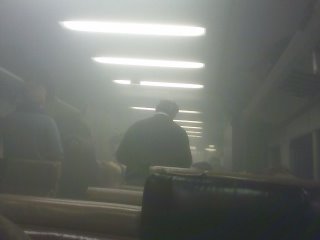
It was a typical Thursday, mid-afternoon, when Metro-North train #1540 pulled out of Grand Central on time at 3:34 pm, heading for New Haven. But this train’s journey on January 26th was to be anything but normal.
As recounted by an eye-witness, here is what happened.
Snaking its way through the underground yards, the train moved toward the Park Avenue tunnel when passengers in the fourth car of the eight car train started smelling smoke. Though they didn’t know it, a traction motor on the 1994-built M6 car, one of the newest in our aging fleet, had caught fire.
There were no flames, but there surely was smoke, not only in the fourth car but the three others that followed it. As that smoke grew thicker, being pumped into the cars by the ventilation system, passengers started coughing… and looking for help.
Because there is no intercom system on our trains, one of the passengers reached up to the ceiling and pushed the conductor buzzer system used to communicate with the motorman driving the train. A voice came over the PA system and, rather than explaining the smoke condition and what was being done to get help, told them to “lay off of the buzzer!”.
By now the train had stopped, still underground. A conductor moved forward, looking to trip the circuit-breakers for the burning motor and to shut off the HVAC fans still pumping acrid smoke into the cars. When that was finally accomplished, passengers were told to “move forward” to the unaffected cars. The train continued north through the tunnels to 125th Street.
Finally arriving at the above-ground station eight minutes later, the doors opened and the train was evacuated. Another train was dispatched from GCT to pick up the stranded passengers and they continued on their journey. There were no injuries but lots of rattled nerves.
This is at least the third such fire on Metro-North New Haven line trains in recent years. None got much publicity. Were it not for an eye-witness to this fire (who was also equipped with a cell-phone camera) who contacted the Commuter Council, this incident might never have gained attention. (Metro-North initially told me they had no reports of a fire… but there had been a “smoke condition”. Well, where there’s smoke…)
It will be at least two to three more years before our new M8 cars are in service, so what do I say to commuters who ask: Is it safe to ride Metro-North existing fleet of 30+ year old cars? What if this smoky fire had been a terrorist attack? Was “lay off the buzzer” the best the railroad could say to panicked passengers in a smoke-filled car? Will there be more such incidents, and if so, how can we handle them better?
The Commuter Council will be following up on this case with the authorities, and I’ll let you know what we find.
-----------------------------------------------------------------------
JIM CAMERON has been a commuter out of Darien for 14 years. He is Vice Chairman of the CT Metro-North / Shore Line East Rail Commuter Council, and a member of the Coastal Corridor TIA and the Darien RTM. You can reach him at jim@camcomm.com or www.trainweb.org/ct . For a full collection of “Talking Transportation” columns, see www.talkingtransportation.blogspot.com


